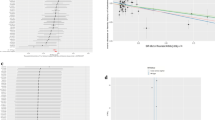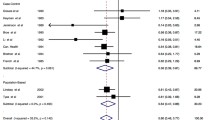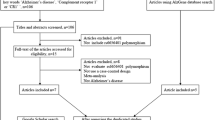Abstract
Objective
This study aimed to examine whether rheumatoid arthritis (RA) is causally associated with Alzheimer’s disease (AD).
Methods
We performed a two-sample Mendelian randomization (MR) analysis using the inverse-variance weighted (IVW), weighted median, and MR-Egger regression methods. We used the publicly available summary statistics datasets from three-stage trans-ethnic genome-wide association studies (GWAS) meta-analyses of 29,880 RA cases and 73,758 controls as exposures and a meta-analysis of 4 GWAS datasets consisting of 17,008 AD cases and 37,154 controls of European descent as outcomes.
Results
We selected 80 single nucleotide polymorphisms (SNPs) from GWAS data on RA as instrumental variables (IVs), 60 of which were associated with RA on a genome-wide significance level. The IVW method showed evidence to support an inverse causal association between RA and AD (β = −0.039, standard error [SE] = 0.017, P = 0.021). MR-Egger regression revealed that directional pleiotropy was unlikely to be a source of bias in the results (intercept = 0.002; P = 0.649). The MR-Egger analysis showed no causal association between RA and AD (β = −0.050, SE = 0.030, P = 0.096). However, the weighted median approach showed that RA and AD were causally linked (β = −0.078, SE = 0.024, P = 0.001). The funnel plot did not show heterogeneity between IV estimates based on the individual variants.
Conclusions
The MR analysis supports that RA was causally associated with a reduced risk of AD.
Zusammenfassung
Ziel
Die vorliegende Studie zielte darauf ab zu untersuchen, ob rheumatoide Arthritis (RA) in einem kausalen Zusammenhang mit M. Alzheimer stehe.
Methoden
Dazu wurde die Analyse einer 2‑Stichproben-Mendel-Randomisierung (MR) unter Einsatz von Verfahren mit inverser Varianzgewichtung (IVW), gewichtetem Mittel und der MR-Egger-Regression durchgeführt. Die Autoren verwendeten die Metaanalysen der öffentlich zugänglichen zusammenfassenden statistischen Datensätze von dreistufigen transethnischen genomweiten Assoziationsstudien (GWAS) mit 29.880 RA-Fällen und 73.758 Kontrollen als Exposition und eine Metaanalyse von 4 GWAS-Datensätzen mit 17.008 AD(Alzheimer’s disease)-Fällen und 37.154 Kontrollen europäischer Abstammung als Endpunkte.
Ergebnisse
Als instrumentelle Variablen (IV) wurden 80 Einzelnukleotidpolymorphismen (SNPs) aus den GWAS-Daten zur RA ausgewählt, von denen 60 auf einem genomweiten Signifikanzniveau mit RA assoziiert waren. Die IVW-Methode erbrachte Belege für die Stützung eines inversen Kausalzusammenhangs zwischen RA und AD (β = −0,039; Standardfehler, „standard error“, SE: 0,017, p = 0,021). Anhand der MR-Egger-Regression zeigte sich, dass es unwahrscheinlich war, dass die direktionale Pleiotropie eine Quelle für Bias in den Ergebnissen darstellte („intercept“ = 0,002; p = 0,649). Die MR-Egger-Analyse ergab keinen Kausalzusammenhang zwischen RA und AD (β = −0,050; SE = 0,030; p = 0,096). Allerdings zeigte der Ansatz unter Verwendung des gewichteten Mittels, dass RA und AD kausal verknüpft waren (β = −0,078; SE = 0,024; p = 0,001). Der Funnel Plot ergab keine Heterogenität zwischen IV-Schätzwerten auf der Basis der individuellen Varianten.
Schlussfolgerung
Die MR-Analyse lieferte Hinweise darauf, dass die RA kausal mit einem verminderten Risiko für M. Alzheimer verknüpft sei.



Similar content being viewed by others
References
Baxter D, McInnes IB, Kurowska-Stolarska M (2012) Novel regulatory mechanisms in inflammatory arthritis: a role for microRNA. Immunol Cell Biol 90(3):288–292
Bowden J, Davey Smith G, Burgess S (2015) Mendelian randomization with invalid instruments: effect estimation and bias detection through Egger regression. Int J Epidemiol 44(2):512–525
Bowden J, Davey Smith G, Haycock PC et al (2016) Consistent estimation in Mendelian randomization with some invalid instruments using a weighted median estimator. Genet Epidemiol 40(4):304–314
Boyd TD, Bennett SP, Mori T et al (2010) GM-CSF upregulated in rheumatoid arthritis reverses cognitive impairment and amyloidosis in Alzheimer mice. J Alzheimers Dis 21(2):507–518
Burgess S, Butterworth A, Thompson SG (2013) Mendelian randomization analysis with multiple genetic variants using summarized data. Genet Epidemiol 37(7):658–665
Burgess S, Daniel RM, Butterworth AS et al (2014) Network Mendelian randomization: using genetic variants as instrumental variables to investigate mediation in causal pathways. Int J Epidemiol 44(2):484–495
Burgess S, Thompson SG (2017) Interpreting findings from Mendelian randomization using the MR-Egger method. Eur J Epidemiol 32(5):377–389
Burgess S, Thompson SG, Collaboration CCG (2011) Avoiding bias from weak instruments in Mendelian randomization studies. Int J Epidemiol 40(3):755–764
Edwards C, Cooper C (2006) Early environmental factors and rheumatoid arthritis. Clin Exp Immunol 143(1):1–5
Egger M, Smith GD, Phillips AN (1997) Meta-analysis: principles and procedures. BMJ 315(7121):1533–1537
Eriksson UK, Pedersen NL, Reynolds CA et al (2011) Associations of gene sequence variation and serum levels of C‑reactive protein and interleukin-6 with Alzheimer’s disease and dementia. J Alzheimers Dis 23(2):361–369
Ferraccioli G, Bracci-Laudiero L, Alivernini S et al (2010) Interleukin-1β and interleukin-6 in arthritis animal models: roles in the early phase of transition from acute to chronic inflammation and relevance for human rheumatoid arthritis. Mol Med 16(552):11–12
Ferraccioli G, Carbonella A, Gremese E et al (2012) Rheumatoid arthritis and Alzheimer’s disease: genetic and epigenetic links in inflammatory regulation. Discov Med 14(79):379–388
Geekiyanage H, Jicha GA, Nelson PT et al (2012) Blood serum miRNA: non-invasive biomarkers for Alzheimer’s disease. Exp Neurol 235(2):491–496
Hartwig FP, Davies NM, Hemani G et al (2016) Two-sample Mendelian randomization: avoiding the downsides of a powerful, widely applicable but potentially fallible technique. Oxford University Press, Oxford
Hemani G, Zheng J, Wade K et al (2016) MR-Base: a platform for systematic causal inference across the phenome using billions of genetic associations. bioRxiv 16:78972
Hill HA, Kleinbaum DG (2000) Bias in observational studies. Encyclopedia of Biostatistics
Kukull WA, Higdon R, Bowen JD et al (2002) Dementia and Alzheimer disease incidence: a prospective cohort study. Arch Neurol 59(11):1737–1746
Lambert J‑C, Ibrahim-Verbaas CA, Harold D et al (2013) Meta-analysis of 74,046 individuals identifies 11 new susceptibility loci for Alzheimer’s disease. Nat Genet 45(12):1452
Lawlor DA (2016) Commentary: two-sample mendelian randomization: opportunities and challenges. Int J Epidemiol 45(3):908
Lee YH, Bae S‑C, Choi SJ et al (2012) Genome-wide pathway analysis of genome-wide association studies on systemic lupus erythematosus and rheumatoid arthritis. Mol Biol Rep 39(12):10627–10635
Lee YH, Bae SC, Song GG (2013) Hepatitis B virus (HBV) reactivation in rheumatic patients with hepatitis core antigen (HBV occult carriers) undergoing anti-tumor necrosis factor therapy. Clin Exp Rheumatol 31:118–121
McGeer PL, Schulzer M, McGeer EG (1996) Arthritis and anti-inflammatory agents as possible protective factors for Alzheimer’s disease: a review of 17 epidemiologic studies. Neurology 47(2):425–432
Okada Y, Wu D, Trynka G et al (2014) Genetics of rheumatoid arthritis contributes to biology and drug discovery. Nature 506(7488):376
Paaby AB, Rockman MV (2013) The many faces of pleiotropy. Trends Genet 29(2):66–73
Pierce BL, Burgess S (2013) Efficient design for Mendelian randomization studies: subsample and 2‑sample instrumental variable estimators. Am J Epidemiol 178(7):1177–1184
Policicchio S, Ahmad AN, Powell JF et al (2017) Rheumatoid arthritis and risk for Alzheimer’s disease: a systematic review and meta-analysis and a Mendelian Randomization study. Sci Rep 7(1):12861
Rees J, Wood AM, Burgess S (2017) Extending the MR-Egger method for multivariable Mendelian randomization to correct for both measured and unmeasured pleiotropy. Stat Med 36(29):4705–4718
Smith GD, Ebrahim S (2008) Mendelian randomization: genetic variants as instruments for strengthening causal inference in observational studies
Smith GD, Ebrahim S (2004) Mendelian randomization: prospects, potentials, and limitations. Int J Epidemiol 33(1):30–42
Swerdlow DI, Kuchenbaecker KB, Shah S et al (2016) Selecting instruments for Mendelian randomization in the wake of genome-wide association studies. Int J Epidemiol 45(5):1600–1616
Acknowledgements
This study was supported in part by a grant from the Korea Healthcare technology R&D Project, Ministry for Health and Welfare, Republic of Korea (HI15C2958).
Author information
Authors and Affiliations
Corresponding author
Ethics declarations
Conflict of interest
S.-C. Bae and Y.H. Lee declare that they have no competing interests.
This article does not contain any studies with human participants or animals performed by any of the authors.
Additional information
Redaktion
U. Müller-Ladner, Bad Nauheim
U. Lange, Bad Nauheim
Caption Electronic Supplementary Material
Rights and permissions
About this article
Cite this article
Bae, SC., Lee, Y.H. Causal association between rheumatoid arthritis and a decreased risk of Alzheimer’s disease. Z Rheumatol 78, 359–364 (2019). https://doi.org/10.1007/s00393-018-0504-8
Published:
Issue Date:
DOI: https://doi.org/10.1007/s00393-018-0504-8




